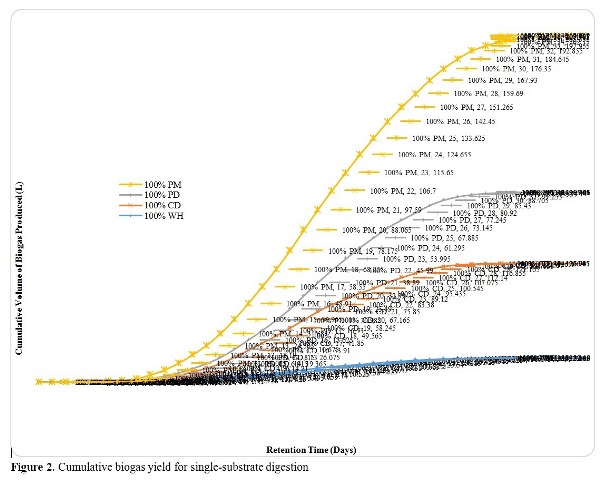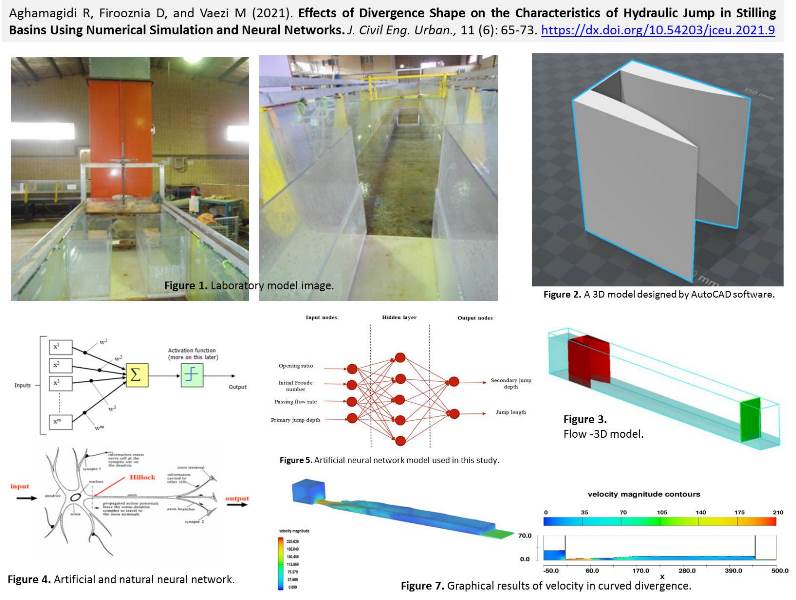Previous issue | Next issue | Archive
Volume 11 (6); 25 November, 2021
Appraisal of Cumulative Volume of Biogas Produced from Water Hyacinth and Selected Animal Dungs Co-Digestion Mixes
Ojo OM, and Babatola JO.
J. Civil Eng. Urban., 11(6): 58-64, 2021; pii:S225204302100008-11
DOI: https://dx.doi.org/10.54203/jceu.2021.8
Abstract
Water Hyancinth (WH) was co-digested with different mix ratios of poultry manure (PM), cow dung (CD) and pig dung (PD). A comparative analysis of the cumulative volume of gas produced from the different co-digestion mixes was carried out. The monitoring of the digestion process was done on a daily basis for a retention period of 40 days. The efficacy of the digestion process as well as the best mix ratio of water hyacinth to the different animal dungs was also evaluated in terms of the volume of gas produced. A rotameter with a capacity of 0.1-1L/Min equipped with a measuring tube was used for the gas flow measurements. From the results obtained the best mix of the PD-aided WH digestion is 3 WH:7 PD while CD - aided WH digestion is 2 WH:8 CD and PM-aided WH digestion is 2 WH: 8 PM. The study also revealed that the PM-aided WH mix produced more biogas compared to the CD-aided and PD-aided WH digestion mix.
Keywords: Co-digested, comparative, cumulative, digestion, biogas.
[Full text-PDF] [ePub] [XML] [Export citation to RIS-EndNote] [Export from Eprints] [How to Cite]
Effects of Divergence Shape on the Characteristics of Hydraulic Jump in Stilling Basins Using Numerical Simulation and Neural Networks
Aghamagidi R, Firooznia D, and Vaezi M.
J. Civil Eng. Urban., 11(6): 65-73, 2021; pii:S225204302100009-11
DOI: https://dx.doi.org/10.54203/jceu.2021.9
Abstract
Measures such as sudden cross-sectional divergence is among the factors affecting the characteristics of hydraulic jump. If for any reason it is not possible or cost-effective to provide the depth required for the hydraulic jump, then gradual or sudden flow cross-sectional divergence can be a good way to reduce the depth required for the jump. In this research, using the neural network and FLOW-3D numerical model, a three-dimensional (3D) model for fluid simulation, the effect of sudden divergence stilling basin on characteristics was simulated. The results of the neural network are very close to the physical model. The study revealed that 3D simulation using Flow-3D software could simulate a hydraulic jump with an average error of 2.41%. The efficiency of stilling basins divergent was calculated to be 71%, which is higher than the classic stilling basins with an efficiency of 53.3%. Depth after jumping in divergent stilling basins modeled at 27.8 and 41.4 l/s was found to be 12 and 25% less than classic basins, respectively. Compared to the classical mode in the divergent stilling basins parabolic, gradual, and sudden, the decrease in jump length was found to be 25.9%, 27.5%, and 31.8%, respectively. The results showed that the sudden divergent stilling basin has the best performance in terms of hydraulic parameters.
Keywords: Neural Network, Simulation, Stilling Basin, Flow-3D, Divergence
[Full text-PDF] [ePub] [XML] [Export citation to RIS-EndNote] [Export from Eprints] [How to Cite]
Previous issue | Next issue | Archive
This work is licensed under a Creative Commons Attribution 4.0 International License (CC BY 4.0)![]()


